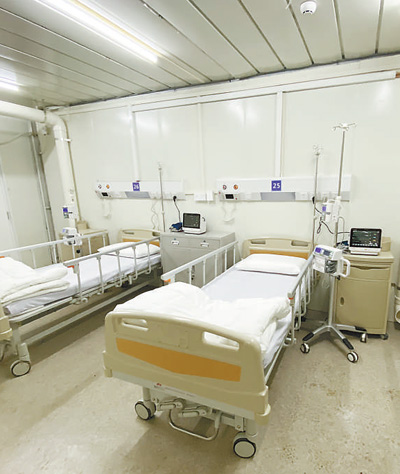


Photo shows a ward of the Huoshenshan Hospital in Wuhan. (Photo/People's Daily)
The Huoshenshan makeshift hospital for accommodating patients infected with the novel coronavirus went into normal operations on Feb. 2. The advanced design concepts and technologies have provided many guarantees for defeating the epidemic in Wuhan.
The hospital has a fishbone layout, making every fishbone an independent medical unit. The design can help to reduce cross-infection as much as possible, according to Ye Jian, director of the technology group of the project with the General Construction Company of China Construction Third Engineering Bureau (CCTEB).
The long middle area serves as the passage for medical staff, while the fishbone area is where the patients get into the hospital. The wards are equipped with more than 700 sets of equipment, such as the ventilation system, air purifiers as well as central oxygen supply systems, to keep the ward air fresh and clean.
Each ward in the hospital has a negative pressure system, and the exhaust air will be discharged outside after being thoroughly disinfected, according to Ye.
The hospital is supported by 17 information systems, which provide strong software and hardware foundations for efficient operation of the hospital. In addition, a remote online consultation system has been built for medical experts to conduct video consultations.
The hospital is designed to minimize air and water pollution to avoid cross infection. The ground structure is separated from underground water as well as the soil by means of a physical approach, and the polluted water is collected through an enclosed system.
The hospital adopts high-standard techniques for wastewater disposal. It was verified that the Huoshenshan Hospital produces about 800 to 1,000 tons of wastewater per day, and the wastewater disposal system is able to handle 2,000 tons of wastewater per day.
In addition, the quantity of disinfectants used to purify the water is greater than that used by many hospitals specialized in handling of infectious diseases, and the time taken to disinfect the water takes about 5 hours, much longer than the national standard of 1.5 hours.
 Fire brigade in Shanghai holds group wedding
Fire brigade in Shanghai holds group wedding Tourists enjoy ice sculptures in Datan Town, north China
Tourists enjoy ice sculptures in Datan Town, north China Sunset scenery of Dayan Pagoda in Xi'an
Sunset scenery of Dayan Pagoda in Xi'an Tourists have fun at scenic spot in Nanlong Town, NW China
Tourists have fun at scenic spot in Nanlong Town, NW China Harbin attracts tourists by making best use of ice in winter
Harbin attracts tourists by making best use of ice in winter In pics: FIS Alpine Ski Women's World Cup Slalom
In pics: FIS Alpine Ski Women's World Cup Slalom Black-necked cranes rest at reservoir in Lhunzhub County, Lhasa
Black-necked cranes rest at reservoir in Lhunzhub County, Lhasa China's FAST telescope will be available to foreign scientists in April
China's FAST telescope will be available to foreign scientists in April "She power" plays indispensable role in poverty alleviation
"She power" plays indispensable role in poverty alleviation Top 10 world news events of People's Daily in 2020
Top 10 world news events of People's Daily in 2020 Top 10 China news events of People's Daily in 2020
Top 10 China news events of People's Daily in 2020 Top 10 media buzzwords of 2020
Top 10 media buzzwords of 2020 Year-ender:10 major tourism stories of 2020
Year-ender:10 major tourism stories of 2020 No interference in Venezuelan issues
No interference in Venezuelan issues
 Biz prepares for trade spat
Biz prepares for trade spat
 Broadcasting Continent
Broadcasting Continent Australia wins Chinese CEOs as US loses
Australia wins Chinese CEOs as US loses